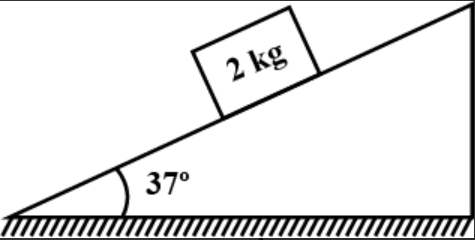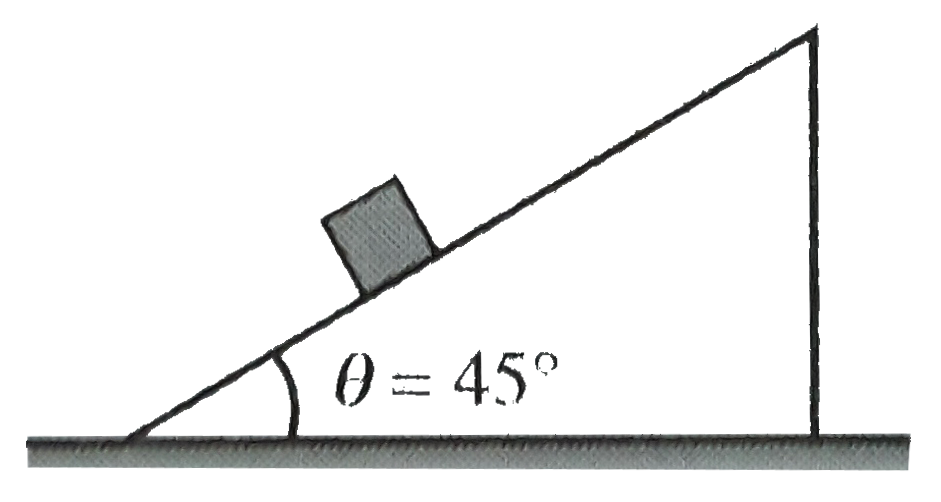A block of weight 100 N is slowly slide up on a smooth incline of inclination 370 by as person. Calculate the work done by the person in moving the block through a distance of 2.0 m, if the driving force is a. parallel to the incline and b. in the horizontal direction.
The correct Answer is:A, B
To solve the problem, we need to calculate the work done by a person in two scenarios: when the driving force is parallel to the incline and when it is in the horizontal direction.
Given Data:
- Weight of the block (W) = 100 N
- Distance moved (d) = 2.0 m
- Angle of inclination (θ) = 37°
Part (a): Work Done When the Force is Parallel to the Incline
1. Calculate the component of weight acting down the incline:
The force due to gravity acting down the incline can be calculated using the formula:
Fgravity=Wsin(θ)
Substituting the values:
Fgravity=100sin(37∘)
Using sin(37∘)≈35=0.6:
Fgravity=100×0.6=60 N
2. Calculate the work done by the person:
Since the person is moving the block up the incline slowly, the force exerted by the person must equal the component of the weight acting down the incline. Therefore, the force exerted by the person (F) is also 60 N.
The work done (W) is given by:
W=F×d
Substituting the values:
W=60×2=120 J
Part (b): Work Done When the Force is in the Horizontal Direction
1. Identify the components of the forces:
When the force is applied horizontally, we need to consider the incline's angle. The horizontal force will have two components: one along the incline and one perpendicular to it. The component of the weight acting down the incline remains the same at 60 N.
2. Calculate the effective force along the incline:
The horizontal force (F_horizontal) can be resolved into components. The component of the horizontal force that acts parallel to the incline can be calculated using:
Fparallel=Fhorizontalcos(θ)
However, we know that the force needed to overcome the weight component down the incline is still 60 N. Thus, the horizontal force must also be equal to 60 N to maintain equilibrium.
3. Calculate the work done:
The work done (W) is given by:
W=Fparallel×d
Since the effective force parallel to the incline is still 60 N:
W=60×2=120 J
Final Answers:
- Work done when the force is parallel to the incline: 120 J
- Work done when the force is in the horizontal direction: 120 J
- Weight of the block (W) = 100 N
- Distance moved (d) = 2.0 m
- Angle of inclination (θ) = 37°
The force due to gravity acting down the incline can be calculated using the formula:
Fgravity=Wsin(θ)
Substituting the values:
Fgravity=100sin(37∘)
Using sin(37∘)≈35=0.6:
Fgravity=100×0.6=60 N
Since the person is moving the block up the incline slowly, the force exerted by the person must equal the component of the weight acting down the incline. Therefore, the force exerted by the person (F) is also 60 N.
The work done (W) is given by:
W=F×d
Substituting the values:
W=60×2=120 J
When the force is applied horizontally, we need to consider the incline's angle. The horizontal force will have two components: one along the incline and one perpendicular to it. The component of the weight acting down the incline remains the same at 60 N.
The horizontal force (F_horizontal) can be resolved into components. The component of the horizontal force that acts parallel to the incline can be calculated using:
Fparallel=Fhorizontalcos(θ)
However, we know that the force needed to overcome the weight component down the incline is still 60 N. Thus, the horizontal force must also be equal to 60 N to maintain equilibrium.
The work done (W) is given by:
W=Fparallel×d
Since the effective force parallel to the incline is still 60 N:
W=60×2=120 J
- Work done when the force is parallel to the incline: 120 J
- Work done when the force is in the horizontal direction: 120 J
Topper's Solved these Questions
- WORK AND ENERGYBOOK - HC VERMA ENGLISHCHAPTER - WORK AND ENERGYEXERCISE - Question for Short Answer
16 Videos
- WORK AND ENERGYBOOK - HC VERMA ENGLISHCHAPTER - WORK AND ENERGYEXERCISE - Objective -2
8 Videos
- WAVE MOTION AND WAVES ON A STRINGBOOK - HC VERMA ENGLISHCHAPTER - WAVE MOTION AND WAVES ON A STRINGEXERCISE - Question for short Answer
7 Videos
Similar Questions
A block of mass 250 g slides down an incline of inclination 370 with a uniform speed. Find the work done against the friction as the block slides through 1.0 m.
View SolutionA block of mass 5.0 kg slides down an incline of inclination 300 and length 10 m. find the work done by the force of gravity.
View SolutionA block of mass m is placed on a smooth inclined plane of inclination θ with the horizontal. The force exerted by the plane on the block has a magnitude
View SolutionA block of mass m is placed on a smooth inclined plane of inclination θ with the horizontal. The force exerted by the plane on the block has a magnitude
View SolutionA block of mass 2 kg rests on an inclined plane of inclination angle 37∘ , then calculate the force of friction acting on the block [ take g = 10m/s2)

View SolutionA block of weight 1 N rests on a inclined plane of inclination θ with the horizontal. The coefficient of friction between the block and the inclined plane is μ. The minimum force that has to be applied parallel to the inclined plane to make the body just move up the plane is
View SolutionA block of mass m=3kg slides on a rough inclined plane of cofficient of friction 0.2 Find the resultant force offered by the plane on the block

View SolutionA body is mass 300kg is moved through 10m along a smooth inclined plane of inclination angle 30∘. The work done in moving (in joules) is (g=9.8ms−2).
View SolutionA block of mass m is moving down with constant velocity along an inclined plane of inclination θ. What is the work done by external force in pulling the block along the inclined plane through a height h with constant velocity?
View SolutionA block of mass 2.0 kg is pushed down an inclined plane of inclination 370 with a force of 20N acting parallel to the incline. It is found that the block moves on the incline with an acceleration of 10ms2. If the block started from rest, find the work done a. by the applied force in the first second b. by the weight of the block in the first second and c. by the frictional force acting on the block in the first second. Take g=10ms2.
View Solution